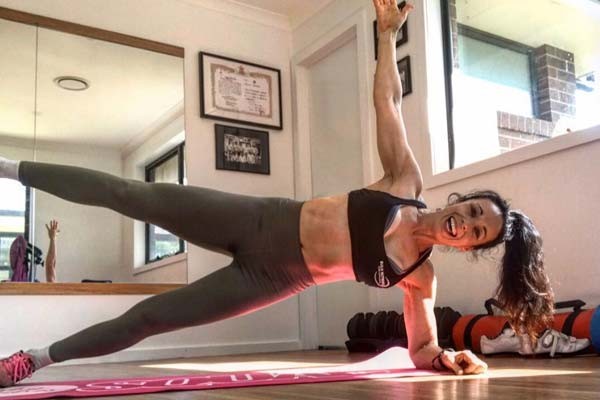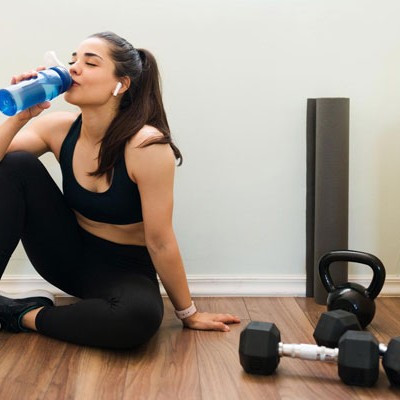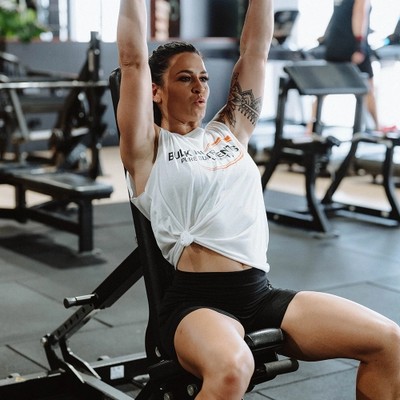How to Workout at Home for Beginners

The importance of staying active and healthy
Physical activity can support your mental health during these uncertain times and also form part of a healthy daily routine, crucial to maintaining when your routine has significantly changed. “Physical activity improves mood and well-being and reduces stress and anxiety,” Dori Rosenberg, PhD, affiliate associate professor at the University of Washington School of Public Health told Travel & Leisure.
“You can also use exercise as a way to organise your day,” Dr Rosenberg says. “Our daily lives can be more stressful when we don’t have a schedule, and exercise can be an anchor.”
Whatever your choice, there’s plenty you can do to set yourself up for success while working out at home.
Here’s how to get the most out of your home workouts. And if you’re still looking for the perfect program to keep you physically fit and boost your mentality while at home, we’ve got some suggestions at the end of this blog.

Get motivated to work out at home
For many people, walking through the doors of the gym sets their workout headspace. The music, the lockers, scoping out the machines you want to use and if your usual workout buddies (or gym “extras” in your workout) are there.
At home, you need to create your own headspace for your own motivation.
Consider roping in your friends or family for a bit of online competition – rather than support. According to Psychology Today healthy competition “appears to trigger a ratcheting-up of physical activity levels that creates an upward spiral within an entire peer group”, according to researchers from the University of Pennsylvania. “Within a competitive framework, each person's activity raises the bar for everyone else and creates a contagious chain reaction marked by increased levels of physical activity for the entire group.”
But it’s competition, not support via social networking which is the key. Apparently, if you’re social networking without the competition, it can be demotivating, and if just one person in a “supportive group” drops out, it can give the rest of the group a subliminal message that it’s okay to take the foot off the accelerator, too.
Unless you’re lucky enough to be able to dedicate a room of your house or your garage to being a full-time workout set up, factor in setting up and packing down your area before and after your workouts.
Assess what equipment you’ll need for your workout – for a pure Tabata workout you may only need a mat for floor work, other programs will call for adjustable dumbbells, resistance bands, a chair or a skipping rope – find it and lay it all out. Don’t get caught out needing to run back inside to find a piece of equipment. The fewer obstacles you have, the better. It sounds simple but it works.
Find some music to get your reps up – check out DJ sets on Soundcloud for some longer mixes – and get ready to go.

Get creative with your space and equipment
You don’t need a treadmill to run a marathon – you just need a balcony, as one French restaurant manager and a Sydney dentist and a have proven.
Depending on what the advice is for your state at the time, you may still be able to run on local tracks – following social distancing, of course, and definitely staying home if you have any signs of illness – and exercise at your local park or oval.
However, it’s entirely possible to build your muscles, raise your heart rate and get a sweat on within your own apartment or backyard.
A chair pushed safely against a wall will work for step-ups, or you might find your deck is the right height for knee-ups and dips.
Walking lunges down the hallway or the side of the housework, or switch up to static lunges.
A skipping rope can be a great replacement for interval running and there’s never been a better time to master double-unders (just practice in heavy track pants and a hoodie to avoid painful whip marks while learning).
Make it count
There’s nothing more demotivating than losing count of where you’re up to during a workout, especially with the more low-fi workouts from books or written programs (rather than automated apps). Some people find it means they start over when they lose count after the fifth of 12 exercises, others find it makes them abandon the workout early.
This one is especially relevant when you’re counting reps within a timed round – if you’re focused on the time you’re meant to finish, how many reps you’re doing AND what your form is like or the process for an unfamiliar exercise, it’s too much for your brain to remember.
Don’t try and remember what time it was when you started and then remember what time it’ll be when you finish. It’s too many numbers. Just set the timer on your phone and let it run. Handily or creepily for iPhone users, if you work out at a similar time each day, Siri will start suggesting a timer to start for your sessions around that time.
The same goes for if you need to do multiple rounds of the same workout. By round three or four it can be impossible to remember if it really is round three or round four.
Search for “rep tracker” in the App Store or Google Play for repetition counters or use anything you’ve got lying around the house – like pegs, cutlery, Lego pieces or books – and move them from one side of your exercise space to the other as you complete each round. It’s one less thing you have to worry about, and then you can focus on your form.
Don’t let the week derail your workouts
Preparation is everything. Look through the workouts for the week and look at what equipment you’ll need.
If you have a workout that’s heavy on skipping and you prefer to do your skipping outdoors, even check the weather to pick one of the clearer days to work outside (unless you love skipping in the rain).
When your social life gets back to normal again after a few months, and you realise you might need to skip a workout (but remember: #NeverMissAMonday), then prioritise your full-body workout for the week and skip one of the more targeted ones.

Remember: this is temporary
We are living in extraordinary times. Many of us are working from home, many more of us have children studying at home or staying home from child care. We’re not seeing our friends, our family and our gym buddies. This is temporary.
Make the most of every workout you do and don’t beat yourself up if you’re not working out as often, with the same intensity or in the same way as you’re used to. Every workout you do is better than one you don’t. And before you know it, you’ll be back to the gym or you might even have discovered a new home workout routine to add to your arsenal.
Resources
- Fitness Blender – FREE full-length home workout videos.
- Sweat by Kayla Itsines or get the Kayla Itsines BBG bodyweight e-books from her original program.
- The Bod by Sophie Guidolin.
- Austin Dunham callisthenics workouts. Don’t be fooled by the name – in the US, calisthenics are what they call bodyweight workouts.
- Rusty Moore’s Visual Impact courses – the women’s course can be done at home with an adjustable bench and adjustable dumbbells, the men’s course can be done using free weights, bodyweight, kettlebells, resistance bands.
- Tabata trainer – an app that comes with pre-loaded exercises, inbuilt timer and you can run your music through it.
- Yoga with Adriene – 6 million people can’t be wrong!
References:
- Bergland, C., 2016. Study Identifies No. 1 Source Of Motivation To Exercise More. [online] Psychology Today. Available at: https://www.psychologytoday.com/au/blog/the-athletes-way/201610/study-identifies-no-1-source-motivation-exercise-more.
- Carter, K., 2020. How To Exercise During The Coronavirus Outbreak — And Why You Should (Video). [online - removed] Travel + Leisure.
Related Blogs

Will Home Workouts Help Me Lose Weight?
Posted by Dayne Hudson
Estimated reading time: 6 minutes

Scientific Booty Building We Can Learn From Instagram Girls
Posted by Dayne Hudson
Estimated reading time: 6 minutes

How to Blast Your Legs With Kettlebells
Posted by Dayne Hudson
Estimated reading time: 5 minutes




























